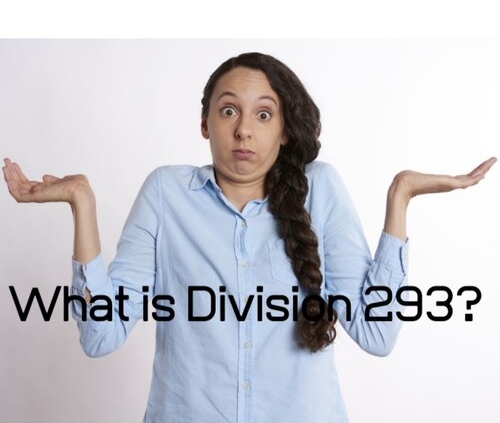I really hate speaking in the ATO language which involves quoting legislation and expecting the Australian taxpayer to understand what they are talking about. Like Division 7A, there really is no other way to talk about Division 293 but by its name. We get asked more questions about this than anything else. If you receive a Division 293 notice you probably have no idea why, and the first thing you will do is call your tax agent. Perhaps reading this will help to explain it a little more.
Division 293 has been around since 2013. It was introduced by our politicians to help make our tax system fairer. The premise is based around the flat tax rate applied to superannuation funds. Superannuation contributions that are made by your employer or as a personal tax deduction are taxed in your superannuation fund at 15%. The flat 15% was charged on the superannuation contributions of the 18 year old working a part time job and earning $15,000 a year, as well as the top executives on seven figure salaries.
In order to even things up the government introduced a Low Income Super Tax Offset for the lower income earners, and Division 293 for those high income earners.
If you qualify for the Low Income Superannuation Tax Offset it will be paid directly to your superannuation fund. The offset is paid to those who earn less than $37,000 and is capped at $500 each year. It is calculated on 15% of the contributions made to your fund, effectively taking the tax rate back to 0% on those contributions. You do not have to do anything to get this, except lodge your tax return and ensure that your superannuation fund has your tax file number.
Division 293 is a different matter as the tax is levied on you personally rather than your superannuation fund. Why? You may prefer to keep your superannuation balance high and pay the tax personally. The ATO give you that choice. The assessment will levy an additional 15% tax on the superannuation contribution that have been made, effectively taxing them at 30%
Division 293 is levied on anyone who exceeds the Division 293 threshold of $250,000. Prior to 1 July 2017 to threshold was $300,000 and this reduction has resulted in many more taxpayers being effected. The Division 293 threshold is made up of Division 293 income plus Division 293 superannuation contributions.
Division 293 Income
For the full list of what is included in Division 293 income see the ATO website, but essentially it is your taxable income plus any reportable fringe benefits. You also add back any rental or investment losses, and this is what causes a lot of confusion. Note, it is not just your taxable income!
Division 293 Superannuation Contributions
For the full list see the ATO website but essentially it includes the superannuation contributions made on your behalf by your employer (superannuation guarantee plus any salary sacrifice or additional contributions) and any other tax deductible contributions that have been made for you, personally or by someone else.
If the combined total of these figures exceeds $250,000, tax will be levied at 15% on your superannuation contributions that are over this threshold. In many cases your contributions will be the full $25,000 and the extra tax will be $3,750.
A couple of things to note. This tax is calculated by the ATO after your tax return has been lodged and after the ATO has matched your data with the contributions reported to them by your superannuation fund. Your tax agent cannot calculate this for you at the time of preparing your tax return as they do not have enough information. They may advise you that you are likely to get a Division 293 assessment but they will not be able to calculate it. This is separate to your tax return and will come some time after your return has been lodged.
You can elect for the payment to be made by your superannuation fund. Once the Division 293 assessment has been made you have 60 days to make this election. The easiest and quickest way to make this election is using your myGov account. You fill out the form as instructed and the money will be paid by your superannuation fund. If you cannot do this the ATO website provides some alternatives.
In most cases the assessment is correct and there is very little we can do to adjust it. If you do think the assessment is incorrect speak with your tax agent. They should be able to guide you through the calculations and determine if an error has been made.
Finally, the ATO does provide good information on this so have a look at their website at this link.
We see a lot of confusion and anger at this assessment. Hopefully this explanation will help you to understand what that frustrating letter from the ATO asking you to pay more tax is all about.



